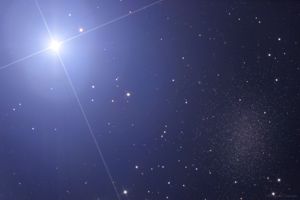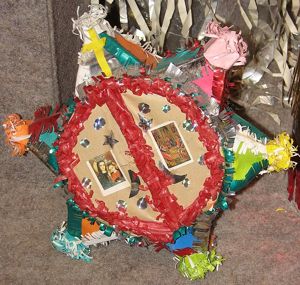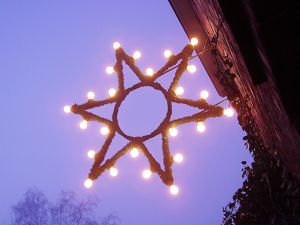Was the Christmas Star real?

Credit: Russell Croman
|
|
The Star of Bethlehem, or Christmas Star, is mentioned in the Bible. It’s said to have led the three wise men to Bethlehem.
It has become a major symbol of Christmas throughout the world.
So imagine, if you will, the silhouettes of three regally attired men on camels. They are gazing across gently rolling hills or dunes of white, to a tiny solitary building in the distance. The night is dark, and one exceedingly bright star appears to hover over the small building, sending a bright shaft of light earthward to illuminate its outline. Another light glows gently inside.
That is the picture most of us have of the Christmas Star, but it’s an image derived more from imagination and greeting cards than from the Bible. In fact, the Gospel of Matthew in the New Testament is the only place this “star” is mentioned in the Bible (Matt 2:2, 7-10, King James Version). Even there, information on the star is sparse. The most telling reference is Matt. 2:9, “When they had heard the king, they departed; and, lo, the star, which they saw in the east, went before them, till it came and stood over where the young child was.” For anyone inclined to insist on the literal truth of scripture, this verse solves the question. If this verse is literally true, then the Star of Bethlehem could not have been any known natural phenomenon, simply because none would move that way.
However, if we grant the author of Matthew – who assuredly was not an eyewitness at the Nativity – a little artistic license, the “star” might not have appeared literally in the way described. In that case we can consider some natural, astronomical possibilities. In fact, there is some uncertainty about the use of the word for star in the Greek manuscript. Some contend that the word could have meant or implied an object other than a physical star.
Some artistic depictions show what appear to be a bright meteor or “falling star.” Although exploding meteors, sometimes called bolides or fireballs, can be startling and truly impressive, they last only seconds. They can occur at any time. People far more aware of the night sky than the modern city dweller is likely would not have placed much significance in them. Such transient phenomena could not possibly have “led” the wise men (the Bible never calls them “kings”) to Bethlehem.

A Christmas-star, the main part of an old Hungarian Christmas-tradition called csillagozás, or star-play. (Jojojoe)
There are other astronomical objects or events that might have seemed more significant, but there are problems. First off, we don’t know for sure when Jesus was born. Due to an error by a Church cleric hundreds of years later, the birth of Jesus was thought to be at least 4 years later than it really was. So today we know that the birth was no later than 4 BC, and it could have been a little earlier. And it certainly was not on December 25. The Bible does not say, leaving us few clues. One clue we do have, however, is the reference that shepherds were out in the field “keeping watch over their flock by night” (Luke 2:8), something the scholars say was likely only done in the spring when lambs were born. Thus the birth was likely in the spring, probably between 7 and 4 BC.
Few astronomical records were kept at the time, except by the Chinese and Koreans. They did record what might have been comets in 5 and possibly again in 4 BC. The main problem here is that comets were generally regarded as omens of evil and bad fortune by the Chinese and likely also by the magi-astrologers the New Testament calls “wise men.” Rather than follow such a cometary “star,” they likely would have gone the other way.
Another possibility is that the Christmas Star was a nova or supernova, a previously unseen star that suddenly brightens in a big way. Indeed, one such star was recorded by the Chinese in the spring of 5 BC, and was seen for more than 2 months. However, its position in the constellation Capricornus meant that it likely would not have seemed to “lead” the wise men in the manner implied in the Bible.
For some, the star was not really a star at all, but a planet, Jupiter. Or more precisely, it was the conjunction or close meeting of Jupiter with two other planets, Saturn and Mars. Planets were “wandering stars” to the ancients, and to many they bore great astrological or mystical significance. Astronomers know that there was a series of such conjunctions in 6 and 5 BC, occurring in the constellation Pisces (the Fishes), said by some to be the astrological “sign of the Jews.” To add more credence for later Christian writers such as Matthew, the sign of a fish later became the secret sign for Christians.
Unless some major and indisputable archaeological discovery is found to settle the question once and for all, the mystery of what the Christmas Star was will remain in the realm of faith. Science cannot explain it as any known physical object; history offers no clear record; and religion offers only an untestable miraculous apparition. But although there may be no agreement on the nature of the star or even its actual sighting two millenia ago, all sides can agree on the message the Christmas star heralded: “…on earth peace, good will toward men.” (Luke 2:14)



No comments:
Post a Comment